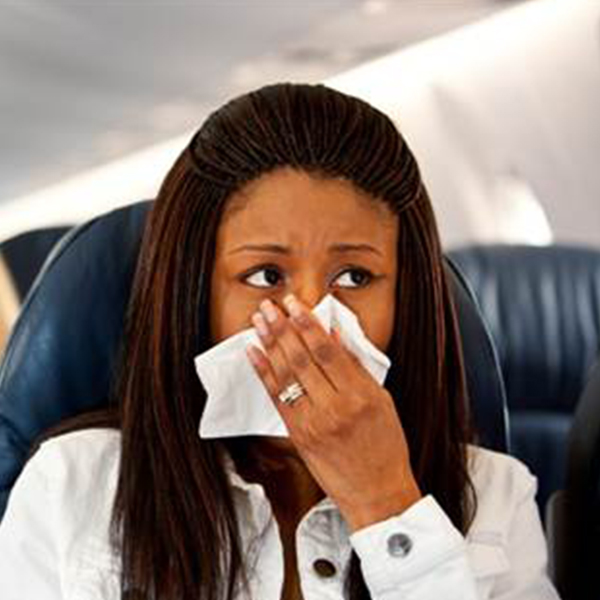9 Tips For Flying Healthy
1. STAY WELL HYDRATED/ NASAL PASSAGE PROTECTED
Planes have very low cabin humidity due to the low humidity found at high elevation, which dries the nasal passages and the throat. This inhibits the body’s natural drainage system that carries any viruses or bacteria encountered on a plane (and there are many) down to the stomach to be flushed out. Keep these key defenses working by drinking plenty of water both prior to the flight and while in the air. (Not soft drinks- WATER). Nasal mists and saline nasal solution have proven to be very effective in keeping nasal passes moist which boosts your body’s own germ-flushing action. Also consider moisturizing the inside of your nostrils with Neosporin (an anti-bacterial) ointment available over-the-counter.
2. BE ON GUARD AGAINST AIRLINE FOOD-BORNE BACTERIA
This may not be so much of a problem for NBA charters that utilize high quality food catering. However, FDA inspection reports show that unsanitary and unsafe conditions have been found in many of the catering options that have provided food to the general airlines in the last two years. While on-board, you may be best served by focusing on packaged snacks or on long flights, you may want to consider pre-packaged food items to take on-board. Airborne, eat lots of fruit: apples, bananas, and oranges.
3. DISINFECT
The common cold, other germs and virus’ can live up to three hours on shared surfaces such has armrests, tray tables, door handles and seat pockets located throughout the airplane cabin. You may want to work with the Athletic Trainer on your staff to urge the plane charter company to make double sure the plane is carefully and fully cleaned disinfected prior to boarding each time you fly. Be prepared with disinfectant wipes to wipe down tray tables, arm rests, remotes, seatbelt clips, window shades, and touch screen devices; keep items out of the seat pockets. Consider supplying all team personnel with an alcohol-based hand sanitizer for usage during the flight.
4. WASH YOUR HANDS
The hands are commonly the first to come into contact with the cold, flu, and other germs. It is a direct line- from the previously mentioned, armrests, tables, door handles, and seat pockets, directly to a fever a few days later. Thorough hand washing should be done before eating in-flight and should be repeated immediately after the flight. Since an airplane cabin is a tight quarter, an alcohol-based hand sanitizer will temporarily suffice if the lavoratory is not a good option.
5. DENTAL HYGIENE
Just to add another layer of protection, gargling/ using germ-killing mouthwash or a salt water solution in-flight while simultaneously washing your hands and disinfecting and wiping everything down before use, all these steps will help protect and keep the throat moist and germ free.
6. “FRESH” AIR
Refrain from closing all the way the air vent that is usually guilty of delivering an icy breeze to your seat. In addition to the low humidity, the lack of circulating ventilation is one of the main reasons airplanes are filled with germs. Active recirculation of the air is filtered air, so planes equipped with good ventilation systems have lower cold and flu transmission rates than those that don’t.
7. CHEW GUM
With take-off and landing the body goes through intense pressure changes. Chewing gum will help release pressure on the ears and the head. Chewing gum also keeps the mouth and throat moist.
8. TAKE VITAMINS REGULARLY
Yes, the efficiency and benefits of taking vitamins on a regular basis remain unproven. But many frequent flyers swear by them. Taking a daily multivitamin regimen may reduce the severity or duration of cold or flu like symptoms.
9. IN-FLIGHT NAUSEA AN ISSUE? – Purchase An Acupressure Wrist Band, Sit Near the Wings, Try To Remain In Your Seat As Much as Possible
Although there is a lack of scientific evidence, using an acupressure wristband available at your local pharmacy may help avoid nausea when flying. The wings are one of the most stable parts of the plane so sitting by the wings will keep the brain signal confusion to a minimum. Sitting in your seat means that sudden movements by the plane will affect you less.
For More In-Depth Tips Visit:
http://www.caring.com/articles/7-ways-to-avoid-getting-sick-when-you-fly
http://www.independenttraveler.com/travel-tips/air-travel/avoiding-the-airplane-cold

